Kenneth L. Gentry Jr.'s Blog, page 13
August 6, 2024
666?
 PMW 2024-061 by Kenneth L. Gentry, Jr.
PMW 2024-061 by Kenneth L. Gentry, Jr.
One of the continuing interests that laymen have in Revelation regards the number 666. This dreaded number appears in Revelation 13:18:
“Here is wisdom. Let him who has understanding calculate the number of the beast, for the number is that of a man; and his number is six hundred and sixty-six.”
Who among us has not feared $6.66 coming up on his cash register receipt? Or worse yet, 666 appearing in his Social Security number!
The significance and usefulness of this number lies in the fact that in ancient days alphabets served a two-fold purpose. Letters functioned, of course, as phonetic symbols from which written words could be formed. But they also served as numerals, in that the Arabic numbering system was a much later development of history. Roman numerals are perhaps the most familiar example of this.
Due to this ancient phenomenon of the two-fold use of alphabets, riddles employing numbers which concealed names were common. [1] Any given name could be reduced to its numerical equivalent by adding up the mathematical value of all of the letters of the name. Archaeologists have discovered many of these as graffiti on city walls that have been excavated. Many more appear in ancient literature, as well.
The Divorce of Israel: A Redemptive-Historical Interpretation of Revelation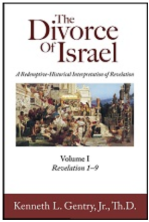
This long-awaited commentary has now been published. It is an 1800 page, two-volume deeply exegetical, academic commentary on the Bible’s most mysterious book.
Click: https://www.kennethgentry.com/the-divorce-of-israel-2-vols-by-gentry-pre-publication-offer/
See more study materials at: www.KennethGentry.com
When John, then, gave a numerical value as a partial concealment of the name of the Beast (Rev. 13:18), he was engaging in a common practice in his day. If we could decipher the name hidden in the number, we could point to the identity of the Beast. This, in turn, could be helpful in determining the date of Revelation.
Searching for 666
As we seek to learn the identity of 666, there are several principles of interpretation which we must keep in mind to govern our thinking. As is evident from the history of the interpretation of 666, we certainly do need something to confine our thinking to the realm of the reasonable. The necessary, textually derived limiting features are:
1. We must understand that the number is not a series of three 6s. But is a full value of “six hundred and sixty-six,” as per the Greek text.
2. The name-number 666 must be “that of a man” (Rev. 13:18b). This excludes any interpretation that would involve demonic beings, philosophical ideas, political movements, or any other non-human concept.
3. It must speak of one of John’s contemporaries. This is due to the temporal expectation of John (Rev. 1:1,3,19; 22:6ff). This principle alone will element 99.9% of history’s suggestions.
4. The name must be that of someone relevant to the first century Christians to whom John wrote. He expected them to give heed (Rev. 1:3) and to calculate the Beast’s number (Rev. 13:18).
5. This man must be someone of evil, blasphemous nature. This is required in light of his character as outlined in Revelation 13.
6. He must also be someone possessing great authority (Rev. 13:2,7). This almost certainly demands a political figure.
The Beast of Revelation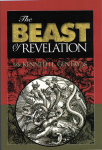
by Ken Gentry
A popularly written antidote to dispensational sensationalism and newspaper exegesis. Convincing biblical and historical evidence showing that the Beast was the Roman Emperor Nero Caesar, the first civil persecutor of the Church. The second half of the book shows Revelation’s date of writing, proving its composition as prior to the Fall of Jerusalem in A.D. 70. A thought-provoking treatment of a fascinating and confusing topic.
For more study materials, go to: KennethGentry.com
One illustration of the hopeless results gained by ignoring any or all of these obvious limiting factors is found in a dispensational work of the 1970s. In this work we read an amusing and vain attempt to explain the number 666:
“At all times Satan has had to have one or more Antichrist candidates waiting in the wings, lest the Rapture come suddenly and find him unprepared. That is why so many malevolent world leaders have had names whose letters added up to 666 when combined in certain ways. (Depending on which 666 formula is used, at any given moment there are several hundred thousand men in the world whose names add up to 666. It is from this large pool of candidates that Satan has traditionally chosen his ‘man of the moment’).” [2]
Contrary to as competent a scholar as Leon Morris, even, I doubt that “the possibilities are almost endless.” [3] The limiting factors derived from Revelation’s text greatly restrict the realm of possibility.
But to what does this infamous number refer? I will be dealing with this in a brief series of articles. Stay tuned.
NOTES
1. This phenomenon is called a “cryptogram” by modern scholars. Among the Greeks it was called iospsephia (“numerical equality”); among the Jews it was called gimatriya (“mathematical”). See: Alfred Edersheim, Sketches of Jewish Social Life (Grand Rapids: Eerdmans, rep. 1972 [1876]), 289-290.
2. Raymond Schafer, After the Rapture (Santa Ana, CA: Vision House, 1977), 55.
3. Leon Morris, The Revelation of St. John (Grand Rapids: Eerdmans, 1969), 174.
August 2, 2024
JESUS WARNS THE SANHEDRIN
PMW 2024-060 by Kenneth L. Gentry, Jr.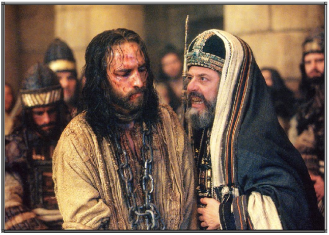
As we near the end of Matthew’s Gospel, we see further evidence of the Jewish rejection of the Messiah and evidence of Gentile inclusion in the people of God. Once again, this helps justify the Olivet Discourse given just a day or so earlier.
In Matthew 26:3–5 Israel’s chief priests and elders along with the high priest counsel Jesus’ death. They begin implementing their evil plan in verses 14–15 where they pay Judas to betray Jesus to them (cp. vv. 21–25, 45). But once again we find another indicator of Gentile inclusion: “Truly I say to you, wherever this gospel is preached in the whole world, what this woman has done will also be spoken of in memory of her” (v. 13).
In Matthew 26:47 the “chief priests and elders of the people” come with Judas to arrest Jesus. The Lord rebukes Peter for taking up a sword to defend him by warning: “Put your sword back into its place; for all those who take up the sword shall perish by the sword” (v. 52). This instructs the disciples that such actions are incompatible with his message (cp. 5:39–42) and against God’s will for his death (26:2, 53–54; John 18:11). But it also probably warns of what will befall Israel as they take up the sword against Rome in AD 66. The violent Jewish reaction to Rome eventually leads to the full-scale Jewish War that destroys Jerusalem and the temple (AD 67–70). Jesus warns of this earlier in Matthew 10:34 (cf. 10:23; cp Luke 22:36–38).
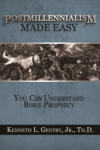
Postmillennialism Made Easy (by Ken Gentry)
Basic introduction to postmillennialism. Presents the essence of the postmillennial argument and answers the leading objections. And all in a succinct, introductory fashion.
See more study materials at: www.KennethGentry.com
In Matthew 26:57 the party arresting Jesus hauls him before Israel’s highest court, a meeting of the Sanhedrin, which consists of the high priest, scribes, and elders. There he undergoes a trial before the high priest who even attempts to present false witnesses against him (v. 59). Prominent in his trail are the reports of his denouncing the temple, though his words are twisted by false-witnesses: “This man stated, ‘I am able to destroy the temple of God and to rebuild it in three days’” (26:61; 27:40; cf. John 2:19).
In Matthew 26:64 Jesus warns that the high priest himself, along with the Sanhedrin, will see him coming in cloud-judgment against them: “Jesus said to him [auto, sing.], ‘You [su, sing.] have said it yourself; nevertheless I tell you [humin, pl.], hereafter you shall see [opsesthe, pl.] the Son of Man sitting at the right hand of Power, and coming on the clouds of heaven.’”
 Political Issues Made Easy
Political Issues Made Easy
by Kenneth Gentry
Christian principles applied to practical political issues, including the importance of borders, the biblical warrant for “lesser-of-evils” voting, and more. A manual to help establish a fundamentally biblical approach to politics. Impressively thorough yet concise.
See more study materials at: www.KennethGentry.com
France well captures the meaning and significance of this statement:
“The ‘coming on the clouds of heaven’ cannot be read as a reference to the parousia, as has been the traditional exegesis until relatively recently. See on 24:30 for a parallel issue, where exactly the same words are used … with reference … to the enthronement of the Son of Man in contrast to the destruction of the temple. There the event predicted was to take place within ‘this generation’ [cf. Matt. 24:34], and here, too, Matthew’s wording demands a fulfillment which is imminent rather than set in the indefinite future: it is something which ‘you’ (the current Sanhedrin members) ‘will see,’ and it will come true ‘from now on’ . . . . In the vindication of the repudiated Messiah and in the powerful growth of the movement which they have attempted to suppress, they ‘will see’ that it is he who is now seated on the heavenly throne.” (France, Matthew (NICNT), 1027–28)
I would note that the NASB’s “hereafter” is based on the Greek ap arti, which is literally translated “from now,” which means “from this point in time.” In Matthew 26:65 the high priest declares that Jesus blasphemes, and as a consequence he tears his high-priestly robes. He intends this to signify his judgment against Jesus. But it is included in the text not only to signify God’s judgment of the high priest, but it also prefigures the coming rending of the temple veil (Matt. 27:51) at Jesus’ death on the cross. The rending of the veil is mentioned only in Matthew’s Gospel. Both of these actions point to the ultimate destruction of the temple. Then the Sanhedrin spit on him and beat, slap, and taunt him (26:67–68).
Click on the following images for more information on these studies:
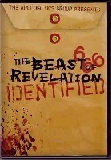

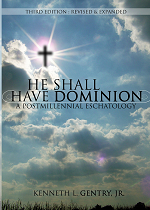
July 30, 2024
JESUS ENTERS JERUSALEM
PMW 2024-059 by Kenneth L. Gentry, Jr.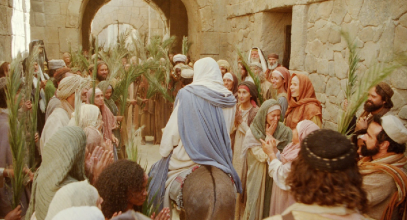
I have been doing a few surveys in Matthew’s Gospel. These are showing the failure of Israel and the expectation of Gentile salvation. I will skip now to the end of Matthew to continue this survey. By this means, I am tracing Matthew’s highly-structured presentation of Jesus’ ministry to show how it leads up to the Olivet Discourse in Matthew 24–25. Now in Matthew 21:10 Jesus enters Jerusalem (for the first time in this Gospel). Jerusalem is the capital of Israel, the home of God’s temple, the seat of the high priesthood and their religious rule over Israel.
Matthew is clearly organizing his material to emphasize Jesus’ climactic entry into Jerusalem to confront and rebuke Israel’s religious authorities. As noted above, this confrontation has been brewing since Matthew 16:21: “From that time Jesus Christ began to show His disciples that He must go to Jerusalem, and suffer many things from the elders and chief priests and scribes, and be killed, and be raised up on the third day” (cp. 20:18).
Now that we are entering into Matthew 21, we must recognize, as France points out, that Olivet is the climax of 21:23–23:39, which presents Christ in the temple. He dramatically enters the temple in 21:12–16 and just as dramatically leaves it in 24:1. [1] Another oddity in Matthew’s presentation is that he never mentions Jesus even going near the temple until he enters it to cast out the moneychangers (21:12–23). In John’s Gospel, however, John mentions the Lord’s appearing there frequently, even at the very beginning of his ministry (John 2:14–15; 5:14; 7:14, 28; 8:2, 20; 10:23; 18:20).
Thine Is the Kingdom
(ed. by Ken Gentry)
Contributors lay the scriptural foundation for a biblically-based, hope-filled postmillennial eschatology, while showing what it means to be postmillennial in the real world.
See more study materials at: www.KennethGentry.com
Jesus carefully orchestrates his public entry into Jerusalem by securing a lowly donkey to ride on (Matt. 21:1–7) in fulfilment of prophecy (v. 5; cp. Zech. 9:9). He seems to be accepted by the common people as they spread their garments before him and cry out: “Hosanna to the Son of David; / Blessed is He who comes in the name of the Lord; / Hosanna in the highest!” (v. 9).
However, only a part of the people’s accolades comes from Scripture (Psa. 118:26). The other part betrays their nationalistic and political expectations as they add to the Psalm reference: “Hosanna to the Son of David.” We will learn that this proclamation does not represent a deep commitment. For not long afterwards the chief priests and elders persuade the multitudes to ask for Barabbas to be released rather than Jesus (Matt. 27:20–21). They then cyry out to Pilate: “Let Him be crucified” (27:22–23).
So then, at Matthew 21:12–13 Jesus enters the temple and casts out the moneychangers and overturns their tables. This is not solely directed at the moneychangers and sellers (and through them the religious authorities who oversee their activities). Rather it is also directed at all who have come to the temple to worship. For Matthew notes that Jesus “cast out all those who were buying and selling in the temple” (v. 12). That is, he is casting out worshipers who are “buying” the sacrificial animals so that they might offer them in worship. The temple has become something contrary to God’s design. By this action Christ is rejecting “the whole system of sacrificial worship.”[2]
This dramatic action is what scholars call “prophetic theater,” a purposely acted out prophecy.[3] As Nolland well observes: This “seems to be yet another instance of prophetic symbolism. The other temple texts to which it perhaps has some relationship are the prophecy of the temple’s doom in 24:1–2 (cf. v. 15) and the accusation against Jesus in 26:61; 27:40.”[4] As Wright expresses it: “Jesus not only predicted its destruction, but symbolized it in his prophetic action, commonly called its ‘cleansing.’” [5] Jesus is here symbolically acting out the overthrow of the wealth-producing temple in AD 70 (as noted in antiquity, it was a “temple of immense wealth,” Tacitus, Hist. 5:8).
THE APOCALYPSE OF JOHN
by Milton S. Terry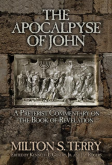
This book is Terry’s preterist commentary on the Book of Revelation. It was originally the last half of his much larger work, Biblical Apocalyptics. It is deeply-exegetical, tightly-argued, and clearly-presented.
For more study materials: https://www.kennethgentry.com/
We may see that Jesus intends his actions as prophetic theater by the following: (1) He could not have been attempting to put a final stop to all the merchandising activity, for one man could not stop the whole enterprise in the enormous temple. Yet Jesus acted alone and did not even call upon his disciples to assist him. (2) We do not read of him coming back to the temple to see that this merchandising was no longer operating, nor do we read of his taking any further action against it.
(3) Jesus specifically quotes a verse from a famous passage in Jeremiah: “My house shall be called a house of prayer” (Matt. 21:13; cp. Jer 7:11). In its original context this verse is a part of God’s denunciation of the Old Testament temple and his warning of its coming destruction (Jer. 7:1, 13–15, 20) despite Israel’s confidence in it (Jer. 7:4). [6]
(4) When the chief priests and elders demand to know by what authority Jesus does this (Matt. 21:15–16), he directly links himself back to John the Baptist who prophesies Israel’s coming judgment (vv. 23–26; cp. 3:1, 7–12). (5) Matthew seems to confirm this by the next action Jesus undertakes just seven verses after his “cleansing”: he curses the fig tree (vv.18–19). (6) Not much later he will declare the temple desolate (23:38) and announce its coming destruction (24:2).
Following quickly upon this action, in Matthew 21:19–21 Jesus curses the fig tree and speaks of the mountain being thrown in the sea. The curse on the fig tree is certainly “an acted symbol of judgment to come on Jerusalem.” [7] Otherwise, it would be an uncharacteristic, vindictive display of destructive power by Christ. This action seems to reflect Micah’s lament regarding Israel’s lack of fruit and of the absence of godly persons in the Land (Mic. 7:1–2). In fact, Jesus gives a fig tree parable expressing the same truth in Luke 13:6–9, which summarizes his three-and-one-half year ministry to fruitless Israel. The Lord’s curse symbolically warns that Israel “has reached a point of no return.” [8]

As It Is Written: The Genesis Account Literal or Literary?
Book by Ken Gentry
Presents the exegetical evidence for Six-day Creation and against the Framework Hypothesis. Strong presentation and rebuttal to the Framework Hypothesis, while demonstrating and defending the Six-day Creation interpretation.
See more study materials at: www.KennethGentry.com
This whole cursing of the fig tree episode is surprising as we may discern from Mark’s version. Mark specifically notes that “when He came to it, He found nothing but leaves, for it was not the season for figs” (Mark 11:13). This alerts us to the fact that Jesus’ desire was not actually to find food. Rather, he was making a dramatic point about Israel’s fruitlessness and her coming judgment. The Lord frequently states in his ministry: “He who has ears, let him hear” (Matt. 11:15; 13:9, 43). His disciples must carefully consider what he is doing here — not long after denouncing the temple and all of its worshipers (21:12–13). Before long he will give a parable about how Israel was nurtured by God but failed to produce fruit (see below at 21:33–45) and how God will take the kingdom from her and give it “to a nation producing the fruit of it” (21:43).
The use of this proverbial saying about casting a mountain into the sea probably refers to the destruction of the temple. Several commentators apply the parallel account in Mark 11:23 to the destruction of the temple. Hooker notes that this mountain “may well have been understood by Mark as a reference to the temple mount…. Mark has here reminded us that the withered fig tree and the action in the temple have the same significance.” [9] Gray agrees: “Just as the withered tree was a symbol of the temple’s fate, so too the mountain cast into the sea reaffirms Jesus’ condemnation of the temple.” [10] Wright well notes that “anyone using this language while standing in the vicinity of the Mount of Olives and looking towards the city could only mean one thing, especially in the first century,” i.e. the temple mount. [11]
Speaking directly of Matthew’s version, Brown comments: “That this story of the fig tree points back to Jesus’ judgment upon the temple is confirmed by this reference to a mountain. As they return to Jerusalem from Bethany, the obvious referent of ‘this mountain’ would be the Temple Mount itself, further underscoring its coming judgment.” [12] Blomberg agrees: “As Jesus and company were traveling from Bethany to Jerusalem, they would be facing Mount Zion, the temple mount. Jesus’ community will therefore see the overthrow of the temple — physically in A.D. 70 and spiritually with Jesus’ death and resurrection in just a few days…. It is almost certainly correct to see in this passage a foreshadowing of the destruction of the sacrificial system in Israel.” [13] See also W. R. Telford.[14]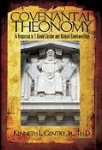
Covenantal Theonomy
(by Ken Gentry)
A defense of theonomic ethics against a leading Reformed critic. Engages many of the leading objections to theonomy.
See more study materials at: www.KennethGentry.com
Though Scripture can speak proverbially of moving mountains (Isa. 40:4; 45:2; 49:11; Zech. 4:7), here in Jerusalem Jesus is being more specific for he is referring to “this mountain [Gk., to orei touto]” (Matt. 21:21).
After this, Matthew records a series of parables and vigorous dialogues between Jesus and Israel’s religious authorities: the chief priests (Matt. 21:15, 23, 45), scribes (21:15; 23:2, 13ff), elders (21:23), Pharisees (21:45; 22:41; 23:13ff), Herodians (22:15–16), and the Sadducees (22:23– 24). His three warning parables in 21:28–22:14 clearly show his denunciation of Israel’s leaders and their coming judgment.
In Matthew 21:28–32 we read the parable of the two sons. This parable sets up a demeaning contrast between the religious leaders and the outcasts of Jewish society. The first son represents the religious authorities who claim to be obedient to the father but who are not (v. 30). The second son represents “the tax-gatherers and harlots” (v. 31) who will enter God’s kingdom before “you,” i.e., the chief priests (vv. 31–32, cp. v. 23). Once again Jesus highlights the failure of Israel’s leaders (cp. 3:7–10; 12:38–42; 15:1–7).
In Matthew 21:33–45 Jesus presents the parable of the landowner. In this parable the landowner obviously represents God, and his vineyard pictures Israel (Isa. 5:7; cp. Isa. 5:1ff; Psa. 80:8; Jer. 12:10). The “tower” points to the temple, in both Isaiah 5:2 and Matthew 21:33 (cp. Mic. 4:8). The landowner carefully prepares his vineyard, then rents it out to vine-growers (Israel’s leaders) expecting to receive its produce (its fruit).
The Reformed Eschatology of Geerhardus Vos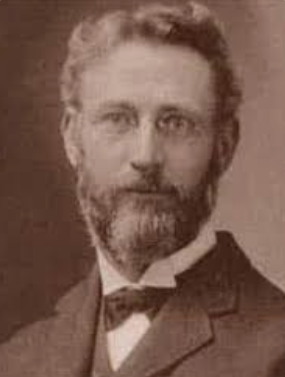
Ed. by Ken Gentry and Bill Boney
This collection of several key eschatological studies by the renowned theologian Geehardus Vos will be published in late Summer or early Fall 2024. We have modernized Vos’ grammar and syntax and updated his publications according to modern style conventions (shorter sentences and paragraphs).
For information on the upcoming Geerhardus Vos work, see:
https://axeheadpress.com/pages/coming-soon-vos
When the time for its harvest comes, the owner sends his “slaves” (Gk.: doulos) to receive his produce. These represent the prophets who are called God’s douloi (“servants”) in the Old Testament (1 Kgs. 18:13, 22–27; 2 Chr. 24:21; 36:15–16; Neh. 9:26; Amos 3:7; Zech. 1:6). But the vine-growers kill them. Then he sends his son, only to have the vine-growers kill him. [15] This indisputably speaks of the religious authorities of Israel killing Jesus (cp. Matt. 16:21; 20:18) for at the end, Matthew informs us: “And when the chief priests and the Pharisees heard His parables, they understood that He was speaking about them” (21:45).
Charismatic Gift of Prophecy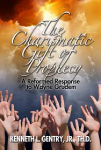
(by Kenneth Gentry)
A rebuttal to charismatic arguments for the gift of prophecy continuing in the church today. Demonstrates that all revelatory gifts have ceased as of the conclusion of the Apostolic era.
See more study materials at: www.KennethGentry.com
According to Jesus’ own interpretation this shows that God will take his kingdom from the Jews, resulting in their being crushed:
“Therefore I say to you, the kingdom of God will be taken away from you, and be given to a nation producing the fruit of it. And he who falls on this stone will be broken to pieces; but on whomever it falls, it will scatter him like dust.” And when the chief priests and the Pharisees heard His parables, they understood that He was speaking about them. (Matt. 21:43–45)
This is all based on the theological fact that God owns “the Land” (Lev. 25:23) and dwells therein (Num. 35:34; cp. Num. 5:3).[16] Because of God’s ultimate ownership, “land and righteousness are inextricably linked.” [17] Thus, when Israel rebels against God, her beloved Land will be judged (Lev. 20:22–26; 26:14–43; Deut. 4:25–27; 28:15–68). God will take the kingdom from Israel and give it to “a nation” that will produce fruit. The word for “nation” is singular, not plural. It speaks of a new “holy nation” (1 Pet. 2:9), the international church which Jesus establishes (Matt. 16:18). As France puts it: “This ‘nation’ is neither Israel nor the Gentiles, but a new entity, drawn from both, which is characterized not by ethnic origin but by faith in Jesus,” i.e., the church, the body of Christ (Eph. 2:11–22).[18]
Notes
1. France, Matthew (NICNT), 886
2. France, Matthew (TNTC), 786.
3. See Old Testament examples of prophetic theater: Isa. 20; Jer 13:1–11; 19; 27:1–15; 32; 43:8-13; Eze. 4:1-3; 4:4–8; 4:9–17; 5:1–54; 12:1–16; 12:17–20; 37:15–28.
4. Nolland, Matthew, 844.
5. Chris Wright in Peter W. L. Walker, ed., Jerusalem Past and Present in the Purposes of God (2d ed.: Grand Rapids: Baker, 1994), 11. N. T. Wright in Borg, Conflict and Holiness, xvi.
6. Oftentimes when Old Testament prophecies are cited in the New Testament they are evoking the whole original context. This interpretive practice is called metalepsis. In antiquity the Scriptures were not divided into chapters and verses, so that metalepsis was the means whereby a writer could point readers to the fuller contexts of a passage.
7. France, Matthew (NICNT), 792. See also: Witherington, Mark, 351; Jordan, Matthew 23–25, 185.
8. France, Matthew (NICNT), 794.
9. Morna D. Hooker, Gospel according to St. Mark (BNTC) (Peabody, Mass.: Hendrickson, 1991), 269.
10. Timothy C. Gray, The Temple in the Gospel of Mark: A Study in Its Narrative Role (Grand Rapids: BakerAcademic, 2010), 52.
11. Tom Wright in Peter W. L. Walker, ed.. Jerusalem Past and Present in the Purposes of God (Grand Rapids: Baker, 1994), 63.
12. Brown, Matthew, 247.
13. Craig L. Blomberg, Matthew (NAC) (Nashville: B & H, 1992), 318.
14. W. R. Telford, The Barren Temple and the Withered Tree (Sheffield: JSOT, 1980), 238–39.
15. Israel is notorious for killing her prophets: 1 Kgs. 18:13; 19:1, 10, 14; 2 Chr. 24:19–21; Neh. 9:26; Jer. 2:30; 26:20–24; Matt. 5:12; 21:35–36; 23:37; Luke 11:47; 13:33; Acts 7:52; Rom. 11:3; 1 Thess. 2:15; Heb. 11:36–37.
16. Since God ultimately owns the land, the Israelites dwell in it as resident aliens or sojourners (1 Chron. 29:15; Psa. 39:12; Heb. 11:13).
17. Gary M. Burge, Jesus and the Land: The New Testament Challenge to “Holy Land” Theology (Grand Rapids: Baker: 2010), 6.
18. France, Matthew (NICNT), 817. See also Craig A Evans, Matthew (NCBC) (Cambridge: University Press, 2012), 375.
July 26, 2024
REVELATION, RE-APPLICATION, INTERPRETATION
PMW 2024-058 by Kenneth L. Gentry, Jr.

All Christians are called by God to study the Bible, for it is his Word designed for and graciously given to us for our good. As Paul says: “All Scripture is inspired by God and profitable for teaching, for reproof, for correction, for training in righteousness; so that the man of God may be adequate, equipped for every good work” (2 Tim. 3:16–17).
And because of this, the Bereans are commended for their studious diligence in seeking to understand the Scriptures: “Now these were more noble-minded than those in Thessalonica, for they received the word with great eagerness, examining the Scriptures daily to see whether these things were so” (Acts 17:11).
Unfortunately, too many believers approach Bible study as a simple, even casual task. They too often try simple proof-texting to build up their theology. Sound biblical study requires more than such a cursory effort. We need all the help we can get; and we need to access proven exegetical observations in order to get into the deeper things of God. The writer of Hebrews warns that: “though by this time you ought to be teachers, you have need again for someone to teach you the elementary principles of the oracles of God, and you have come to need milk and not solid food” (Heb. 5:12). We see this problem in much Christian theological musings today.

THE APOCALYPSE OF JOHN
by Milton S. Terry
This book is Terry’s preterist commentary on the Book of Revelation. It was originally the last half of his much larger work, Biblical Apocalyptics. It is deeply-exegetical, tightly-argued, and clearly-presented.
For more study materials: https://www.kennethgentry.com/
In this brief article, I want to introduce the concept of “re-application.” This concept is not recognized by many Christians as they attempt random proof-texting. This concept is especially important for understanding the Book of Revelation, which is the most Old Testament-oriented book of the New Testament corpus.
Too often when we see a reference to the Old Testament in the New, we assume that it is a direct fulfillment that answers the full meaning of the original text. Such is not necessarily the case, however.
For instance, even though “allusions and echoes are found in almost every verse of the
book,” John “seldom quotes the OT directly” and has “no formal quotations”
whatsoever (Beale and Carson 1081, 1082). The reason he never formally cites
the Old Testament appears to be that he presents his work as a prophecy (1:3;
22:7, 10), in which he himself is taking up the prophetic mantle. And by this he is intentionally mimicking Old Testament prophetic language as he speaks of Israel’s coming judgment. Mazzaferri (379) is surely correct in noting that John “archaises his style to mimic classical biblical Hebrew” in order to reinforce his identity “as a prophet in classical OT style.”
Navigating the Book of Revelation (by Ken Gentry)
Technical studies on key issues in Revelation, including the seven-sealed scroll, the cast out temple, Jewish persecution of Christianity, the Babylonian Harlot, and more.
See more study materials at: www.KennethGentry.com
John does not so much present fulfillments of Old Testament prophecies— which is why he never directly cites them—but rather adapts them for and re-applies them to new circumstances. Though Beale and Carson (1087) argue that “prophecies from the OT are fulfilled in Revelation,” they admit that the various Old Testament prophecies “may be fulfilled in various ways,” including their being subjected to “creative changes” (1085) and even being “creatively reworked and applied.” Indeed, “there is unanimous consensus that John uses the OT with a high degree of liberty and creativity” (Beale 81).
Regarding John’s tendency to adaptation, Mulholland (1990: 342) aptly notes: “The reality of his vision, therefore, was both experienced and conveyed through the matrix of language, myths, and symbols that were drawn primarily from the image pool of the Old Testament and intertestamental Judaism. Frequently the language, images, and even literary forms are “bent out of shape” in the service of an experience that transcends the limits of the old frames of reference. The reality that John experienced was only shadowed or intimated by much of his prevailing image pool. Thus John combined old images and symbols in new ways in order to express the depths of the reality that he experienced. The old images, myths, and symbols have become flexible and polyvalent in the service of a multifaceted visionary experience. Yet they have retained enough of their meaning to be significant aids in understanding what John is conveying.”
The Reformed Eschatology of Geerhardus Vos Ed. by Ken Gentry and Bill BoneyThis collection of several key eschatological studies by the renowned theologian Geehardus Vos will be published in late Summer or early Fall 2024. We have modernized Vos’ grammar and syntax and updated his publications according to modern style conventions (shorter sentences and paragraphs).For information on the upcoming Geerhardus Vos work, see:https://axeheadpress.com/pages/coming-soon-vos
Ed. by Ken Gentry and Bill BoneyThis collection of several key eschatological studies by the renowned theologian Geehardus Vos will be published in late Summer or early Fall 2024. We have modernized Vos’ grammar and syntax and updated his publications according to modern style conventions (shorter sentences and paragraphs).For information on the upcoming Geerhardus Vos work, see:https://axeheadpress.com/pages/coming-soon-vosAs Corsini (88, 104) states of John, “his usual method” is to “take a passage in its original meaning, and then deepen it, altering it as he uses it.” Consequently, Revelation’s Old Testament allusions frequently refer to something other than that of which the prophets originally spoke. For instance, both “Egypt” and “Babylon” have concrete historical meanings in the Old Testament, yet John uses these Old Testament villains in Revelation, maintaining their evil character while reapplying their historical meaning. Thus, Jerusalem, the place where the Lord was crucified, is mystically called “Egypt” in 11:8. In the commentary, I will argue that Babylon also represents Jerusalem, in that she appears in high-priestly attire in 17:4–5 and is distinguished from “the cities of the nations” in 16:19. This suggests that John may even use other Old Testament personnel and nations in a new, dramatic way. It allows that his references to “the kings of the earth” may have a very different meaning than its use in the Old Testament. Indeed, I am arguing that he actually applies this phrase to Israel’s religious aristocracy rather than to the kings of the Gentile nations.
Thus, one should be careful about taking a running jump into this very deep, very Old Testament-oriented book.
July 23, 2024
EZEKIEL 37 AND ISRAEL
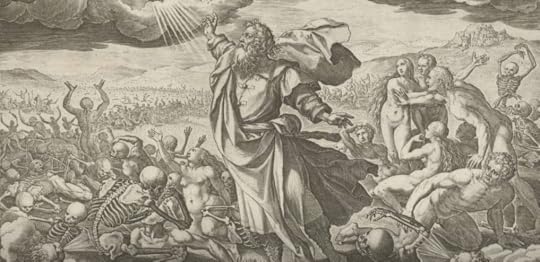 PMW 2024-057 by Patrick Fairbairn
PMW 2024-057 by Patrick Fairbairn
Gentry reader asks:
Thanks so much for all your resources. I’ve been slowly studying the postmil eschatology for about a year now and it has been eye opening. I have a question regarding Ezekiel chapter 37. How does the postmil Eschatology respond to the details of the unification of Israel as a nation and the land promises that seem to be so literal? Thank you! (Z.K.)
Gentry lets Fairbairn respond:
The commentary on Ezekiel by Patrick Fairbairn (1805-1874) is an extremely helpful analysis of this great prophet. I will simply post the relevant portion of his commentary to full answer your question. I am citing from pages 408–412. I will only edit it in terms of more paragraph breaks. Older writers did not believe in paragraph breaks for their weary readers.
“And My servant David will be king over them, and they will all have one shepherd; and they will walk in My judgments and keep My statutes and do them. They will inhabit the land that I gave to Jacob My servant, which your fathers inhabited; and they will inhabit it, they, and their sons and their sons’ sons, forever; and David My servant will be their prince forever. And I will cut a covenant of peace with them; it will be an everlasting covenant with them. And I will give them the land and multiply them and will set My sanctuary in their midst forever. My dwelling place also will be with them; and I will be their God, and they will be My people. And the nations will know that I am Yahweh who sanctifies Israel, when My sanctuary is in their midst forever.”’
House Divided: The Break-up of Dispensational Theology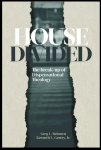 By Greg Bahnsen and Ken Gentry
By Greg Bahnsen and Ken Gentry
This book presents and defends Christian Reconstruction theology, particularly theonomic ethics and postmillennial eschatology. It does to by responding to dispensationalism’s social and exegetical theology.
For more educational materials: www. KennethGentry.com
Here, precisely as in the resurrection-scene of the earlier part, the action with the rods, first writing on them the names of the two ancient divisions of the covenant-people, and then pressing them together into one, is employed merely as a symbol of what was to take place with the people themselves,—a prophecy in action to give distinctness and credibility to the immediately following prophecy in word. And for the direct import of the communication, the close and brotherly union among the members of the covenant, that forms the substance of it, is here presented to our view as an immediate and certain effect of the manifestation of God’s power to revive and bless them, and as the necessary condition to their complete and final establishment.
The whole people of Israel had been represented as participating in the regenerating efficacy of the spirit of life, which was to be given from above: and, as the direct result of this was to unite them to God, so its secondary operation could not fail to be, to unite them in brotherly concord with each other. For the true covenant-people must form but one body, as they can only have one Head; and hence, as the necessary shell for preserving this great truth, it was so strictly enjoined of old, that they should have but one temple, one high-priest, one king, and one commonwealth.
The breaking up of this united brotherhood by the revolt of the ten tribes under Jeroboam, however needful at the time as a salutary chastisement to the house of David, is constantly represented as a sad dismemberment of the church of God, and the source, to a large extent, of the more overwhelming tide of evils which thenceforth set in upon the land, and at last laid it desolate. As soon, therefore, as there might be produced a revived and healthful condition among the covenant- people, there must be a return to brotherly union, and that in connection with the house of David; for to this house had been committed, by an irrevocable decree, the right to rule over the heritage of God, and to abide in separation from it was to continue in rebellion against Heaven.
Nay, not only must the brotherly union find its centre in the house of David, but David himself must again preside over the united brotherhood; since he is pre-eminently that servant of God, whose grand end in ruling was to do the will of God, and promote the ends of his righteous government. This God-honouring king must reign for ever; his rule shall be perpetuated through all generations; that the covenant of peace also may be perpetual, and that God’s sanctuary may constantly abide among the people, and his name be magnified through their pure and prosperous condition. Thus, the order of God being re-established and made sure, there should be nothing any more to interrupt the flow of the Divine blessing; God would be most really present with his people, and the inheritance of good promised in the covenant, hitherto found only in part, be fully and for ever realised.
There is nothing absolutely new in the prophecy; it is substantially a fresh exhibition of the prospect already unfolded in chaps, xxxiv. and xxxvi.; but rendering prominent what was there implied rather than broadly asserted, the formal union of the covenant-people, along with their sanctification and blessedness, under the presidency of David. That there has been no adequate fulfilment of the prophecy in what may be called the literal sense of its terms, is too plain to require any lengthened proof. Some advances were of old made towards it,—that is all that can be said.
Dispensational Distortions
Three Lectures by Kenneth Gentry. Reformed introduction to classic dispensationalism, with analysis of leading flaws regarding the Church, kingdom, redemptive history, and Christ. Helpful for demonstrating errors to dispensationalists.
See more study materials at: www.KennethGentry.com
There was a return, to some extent, of the covenant-people, chiefly indeed of the house of Judah, though not without representatives from the other tribes; a visible display of union among such as did return, a partial repossession of the land of the covenant, and an external reconstruction of the temple and its worship—enough to show that God had not forgotten his word, and that he was ready to bless to the full, if his people had been willing to seek to him for the blessing. But still all, not excepting even the things connected with the temple (see on chap. xxi. 26), were found in a very imperfect and mutilated condition, not after the bright pattern furnished here by the hand of the prophet.
And the most characteristic part of the description—the cementing, strengthening, benignant rule of David—had not even the appearance of a literal fulfilment in the post-Babylonish history of Israel. The prophecy, therefore, has not been accomplished according to the letter in the past; and, with so strong and prominent a feature of an ideal sort as the eternal presidency of David, it seems amazing that any one should expect it to be realised after that manner in the ages to come. For to that end it were indispensable that the literal David should be raised from the dead, and again set over the heritage of God, vested there even with perpetual sovereignty; notwithstanding that Christ has expressly received, by Divine appointment, the throne of his father David.
The Reformed Eschatology of Geerhardus Vos
Ed. by Ken Gentry and Bill Boney
This collection of several key eschatological studies by the renowned theologian Geehardus Vos will be published in late Summer or early Fall 2024. We have modernized Vos’ grammar and syntax and updated his publications according to modern style conventions (shorter sentences and paragraphs).
For information on the upcoming Geerhardus Vos work, see:
https://axeheadpress.com/pages/coming-soon-vos
The prophecy is a detailed picture of coming good, drawn, as such a picture must have been, under the form of the old covenant relations. It exhibits the prospective good, as a revival of Israel’s best periods, freed from their still remaining defects and oft-intermingling judgments; and a picture that could be realised only in part, while the old covenant stood, both from its own inherent imperfections, and from the wilful neglect and obstinacy of its people. Not till the new covenant enters does the comparatively perfect begin to develop itself. For with the coming of Messiah, the head and centre of the new, as David was of the old, everything connected with God’s kingdom takes a loftier flight and a wider range; the shadows vanish away, being supplanted by the substance; and that which before was partial and restricted, presents now the aspect of an expansive freedom and a universal adaptation. The whole earth is as much Christ’s rightful heritage as the territory and people of Canaan were David’s; and only when it becomes his actual possession, can the prophecy respecting him, as the New Testament David, reach its destined accomplishment.
So that to speak now of the prophecy still requiring for its fulfilment a literal Israel, a literal Canaan, a literal tabernacle, with the many outward and fleshly conditions therewith connected, and that too in the face of the palpable incongruity in the heart of the prophecy of a non-literal David, is as if one were to reduce the lofty tree again to the puny dimensions of the plant, or send the man of full-grown stature back to his cradle,—as if, in short, against all the experience of the past, which is ever moving on to something higher and better, we should expect the chariot-wheels of God’s providence to return to their former courses, and keep within the ancient landmarks.
The Divorce of Israel: A Redemptive-Historical Interpretation of Revelation
This long-awaited commentary has now been published. It is an 1800 page, two-volume deeply exegetical, academic commentary on the Bible’s most mysterious book.
Click: https://www.kennethgentry.com/the-divorce-of-israel-2-vols-by-gentry-pre-publication-offer/
See more study materials at: www.KennethGentry.com
It was the peerless glory of Israel as a nation, to give to the world the new David, who was to be for humanity the one child of hope, and to furnish to his hand the first builders of that spiritual house, which was to be formed of renewed souls, and reared on the foundation of his perfected redemption. But there their distinctive honour ceases—not as if their real privileges and blessings were lost, but because these must henceforth be shared in common by the household of faith. The very mother that bore Jesus, and his nearest kindred, could attain to no peculiar place in his kingdom by reason of their earthly connection with him: not these, he said, but every one that heareth the word, and doeth the will of my Father in heaven, is my mother and sister and brother. Thus the fleshly bond was broken at the centre, and it must vanish to the farthest circumference; everything founded on natural relationships and genealogical descent was, with the handwriting of ordinances, nailed to the cross of Christ, and buried in his grave, as a part of that bondage to the elements of the world, from which the church had at length escaped, and which should never more be heard of in her borders.
The one relationship to be accounted of is union to Christ, which renders all who possess it children of Abraham, and heirs according to the promise—heirs, that is, of all that was given to Abraham in promise; more even, if more could be, for they are heirs of God and joint heirs with Christ himself. Therefore, it is folly to speak of robbing the Jew by putting him on a level with the believer in Christ; for to put him there is to raise him to the highest standing that a child of humanity can enjoy, and give him a share in that, which being large enough for all, is not diminished, but rather enhanced by the numbers who partake in it.
And for the church herself, seeing that her exalted Head is now at the right hand of the Majesty on high, with power and authority to make the whole earth his possession, instead of seeking to revive the old distinctions, which have served their day, or hanging her hopes on effete outward arrangements, it is alike her wisdom and her duty to press forward the spiritual conquest of the world,—plying with unwearied diligence the means of its regeneration, and withal waiting and praying for the time when, nature itself being regenerated, the earth shall become the fit abode of manifested Deity, and all shall be full of the knowledge, and resplendent with the glory of the Lord. Then in the fullest sense shall the vision of our prophet be realised; for then the entire territory of the new covenant shall be reclaimed for righteousness, and the tabernacle of the Lord most truly be with men.
Israel in the Bible and History (9 mp3 lectures)
by Ken Gentry
The people of Israel are the people of God. But the modern church is divided over the nature, call and identity of Israel. This lecture series covers key issues for understanding the biblical concept of Israel.
See more study materials at: www.KennethGentry.com
July 19, 2024
PRETERISM IN REVELATION (4)
 PMW 2024-056 by Kenneth L. Gentry, Jr.
PMW 2024-056 by Kenneth L. Gentry, Jr.
As mentioned in the previous article, the theme of divine judgment on Israel fits perfectly with the Olivet Discourse. Virtually all commentators note the remarkable thematic parallels between Matthew 24 and Revelation 6. These parallels are sufficient alone to suggest the same theme, but other correspondences exist.
In Matthew 23 Christ scathingly denounces Israel’s leadership as he approaches the dramatic conclusion of his earthly ministry. He notes that Israel’s present failure is not an isolated event, but the culmination of a lengthy historical pattern — as do Stephen (Ac 7) and Paul (1Th 2:14-16). He concludes his rebuke with a prophecy that Israel will “fill up” (Mt 23:32) her guilt in “this generation” (23:36) when she “persecutes” those Jesus is “sending” (23:34; cp. Ac 8:1; 1Th 2:14-16).
Thereupon, Jesus weeps over Jerusalem (23:37), declares her temple “desolate” (23:38), and ceremoniously departs from it (24:1a). When the disciples express confusion at his rejection of the temple (24:1b), He prophesies its utter destruction (24:2). This specific prophecy prompts the disciples’ questions about the time of this judgment (24:3; though they misunderstand the significance of their own question). Jesus responds with his Olivet Discourse. The first portion of the discourse (24:2-34) focuses particularly on the temple (Mt 24:2) in Judea (v. 16) during that “this generation” (v. 34), just as John’s Revelation focuses on the Jews (1:7; 2:9; 3:9) and the temple (11:1-8) in the near future (1:1, 3; 22:6, 10). As noted previously, both John and Jesus merge Zechariah 12:10 and Daniel 7:13 in this context of approaching judgment upon Israel (Mt 24:30; Rev 1:7). Both prophecies warn of A.D. 70.
[image error]For more information and to order click here.
" data-image-caption="" data-medium-file="https://postmillennialworldview.com/w..." data-large-file="https://postmillennialworldview.com/w..." tabindex="0" role="button" class="alignright size-full wp-image-211" src="https://postmillennialworldview.com/w..." alt="" />Perilous Times: A Study in Eschatological Evil (by Ken Gentry)
Technical studies on Daniel’s Seventy Weeks, the great tribulation, Paul’s Man of Sin, and John’s Revelation.
See more study materials at: www.KennethGentry.com
Furthermore, several other NT passages warn of the Jerusalem’s judgment in A.D. 70. Two are of particular interest:
“Truly I say to you, there are some of those who are standing here who shall not taste death until they see the kingdom of God after it has come with power” (Mk 9:1).
“The Jews, who both killed the Lord Jesus and the prophets, and drove us out. They are not pleasing to God, but hostile to all men, hindering us from speaking to the Gentiles that they might be saved; with the result that they always fill up the measure of their sins. But wrath has come upon them to the utmost” (1Th 2:15-16).
Thus ends the introduction to preterism in Revelation. Now you should be ready to buy The Divorce of Israel. In fact, I recommend buying two copies, just to see if I am consistent.
The Reformed Eschatology of Geerhardus Vos
Ed. by Ken Gentry and Bill Boney
This collection of several key eschatological studies by the renowned theologian Geehardus Vos will be published in late Summer or early Fall 2024. We have modernized Vos’ grammar and syntax and updated his publications according to modern style conventions (shorter sentences and paragraphs).
For information on the upcoming Geerhardus Vos work, see:
https://axeheadpress.com/pages/coming-soon-vos
July 16, 2024
PRETERISM IN REVELATION (3)
 PMW 2024-056 by Kenneth L. Gentry, Jr.
PMW 2024-056 by Kenneth L. Gentry, Jr.
As I continue my brief introduction to preterism in Revelation, we come now to the important: Historical Indicators
I agree with John Lightfoot: Revelation appears to prophesy Christ’s judgment upon the Jews in A.D. 70. John’s opening statement of purpose (1:7), the seven letters (2:9; 3:9), and the body of Revelation (4-19; e.g., 7:1-8; 11:1-8) all reflect this truth.
Just after mentioning the nearness of the events (1:1, 3) and just before alluding to the dire circumstances of his original audience (1:9), verse 7 warns: “Behold he comes with the clouds, and will see him every eye and those who him pierced, and will wail over him all the tribes of the land. Yes, amen” (Alfred Marshall, The Interlinear Greek-English NT; cp. Robert Young, Literal Translation). Though this sounds like a Second Advent reference, the following evidence points to A.D. 70.
Coming with the Clouds. Cloud-coming language often speaks of historical divine judgments. For instance, Isaiah 19:1a warns: “An oracle concerning Egypt: See, the LORD rides on a swift cloud and is coming to Egypt” (cp. Ps 18:7-15; 104:3; Joel 2:1,2; Na 1:2ff.; Zep 1:14,15). This speaks of the Assyrian king Esarhaddon conquering Egypt in 671 B.C. As Young notes: “The scene does not necessarily suggest that the Lord comes from the Temple at Jerusalem nor from heaven, but merely that He comes as a judge” (Isaiah, 2:14), i.e., providentially, not personally.
THE APOCALYPSE OF JOHN
by Milton S. Terry
This book is Terry’s preterist commentary on the Book of Revelation. It was originally the last half of his much larger work, Biblical Apocalyptics. It is deeply-exegetical, tightly-argued, and clearly-presented.
For more study materials: https://www.kennethgentry.com/
Interestingly, John follows Jesus in merging Zechariah 12:10 and Daniel 7:13. Like John, Jesus mentions the “coming on the clouds” (cp. Mt 24:29-30) against Israel (Mt 23:36-24:2, 16). And like John, Jesus ties the events to the near future: “all these things shall come upon this generation” (Mt 24:34).
Those Who Crucified Christ. Christ’s judgment-coming is against: “they who pierced him.” Jesus blames the Jews for his death: “Christ began to show His disciples that He must go to Jerusalem, and suffer many things from the elders and chief priests and scribes, and be killed” (Mt 16:21; cp. Mt 20:18-19; 21:33-43; Mk 8:31; Lk 9:22). The apostles also lay the covenantal blame for his crucifixion upon Israel: “Then know this, you and all the people of Israel: It is by the name of Jesus Christ of Nazareth, whom you crucified” (Ac 4:10a; cp. Jn 19:5-15; Ac 2:22, 23, 36; 3:14, 15; 4:8-10; 5:30; 10:39; 1Th 2:14-16). Revelation 1:7 must refer to the first century in that those who “pierced him” are now long since deceased.
The Tribes of Israel. This judgment brings mourning upon “all the tribes of the land” (1:7; Marshall’s Interlinear). These “tribes” (phyle) must be the tribes of Israel (cf. Mt 19:28; Lk 22:30). TDNT notes that the Septuagint “with few exceptions . . . has phyle, so that this becomes a fixed term for the tribal system of Israel” (9:246). Revelation clearly mentions those Jews who were saved out from “the tribes” of Israel (7:4-8; cp. 21:12); and John sets these over against other “tribes and peoples” beyond Israel (7:9; cp. 11:9).
The Divorce of Israel: A Redemptive-Historical Interpretation of Revelation
This long-awaited commentary has now been published. It is an 1800 page, two-volume deeply exegetical, academic commentary on the Bible’s most mysterious book.
Click: https://www.kennethgentry.com/the-divorce-of-israel-2-vols-by-gentry-pre-publication-offer/
See more study materials at: www.KennethGentry.com
What is more, John associates these “tribes” with “the land” (tes ges), the well-known Promised Land (cp. Lk 21:23). As Edersheim observes: “Palestine was to the Rabbis simply ‘the land,’ all other countries being summed up under the designation of outside the land.” Indeed, the OT mentions “the tribes” and “the land” together in numerous instances (e.g., Ge 49:16; Nu 26:55; Jos 14:1; 19:51; Eze 45:8; 48:29).
In the seven letters John specifically mentions the defection of the Jews from God. He even informs the churches that Christ will vindicate them by judging the Jews:
• “I know your tribulation and your poverty (but you are rich), and the blasphemy by those who say they are Jews and are not, but are a synagogue of Satan.(2:9)
• Behold, I will cause those of the synagogue of Satan, who say that they are Jews, and are not, but lie, behold, I will make them to come and bow down at your feet, and to know that I have loved you.” (3:9)
Surely this humiliation of the Jews was in the lifetime of the recipients of Revelation — in A.D. 70 when the Jews were “cast out” (Mt 8:10-12) and the kingdom was given to the gentiles (Mt 21:40-43).
The Temple and Holy City. Revelation expressly mentions the coming destruction of the temple, and with language drawn from the Olivet Discourse.
“Jerusalem will be trampled on by the Gentiles until the times of the Gentiles are fulfilled” (Lk 21:24b).
“But exclude the outer court; do not measure it, because it has been given to the Gentiles. They will trample on the holy city for 42 months” (Rev 11:2).
Note that both of these passages inform us that the “holy city/Jerusalem” will be “trampled” by the “gentiles.” And both appear in prophecies confined to the short term (1:1, 3; 22:6, 10; Lk 21:31-32). Evidently, these texts are referring to the same events, with John deriving his cue from Christ’s discourse about A.D. 70 (Lk 21:6-7).
[image error]For more information and to order click here.
" data-image-caption="" data-medium-file="https://postmillennialworldview.com/w..." data-large-file="https://postmillennialworldview.com/w..." tabindex="0" role="button" class="alignright size-full wp-image-209" src="https://postmillennialworldview.com/w..." alt="Navigating the Book of Revelation: Special Studies on Important Issues" />Navigating the Book of Revelation (by Ken Gentry)
Technical studies on key issues in Revelation, including the seven-sealed scroll, the cast out temple, Jewish persecution of Christianity, the Babylonian Harlot, and more.
See more study materials at: www.KennethGentry.com
Interestingly, the time of the formal imperial engagement of the Jewish War until the destruction of the temple was forty-two months. According to Bruce, after the initial Jewish uprising in A.D. 66, Vespasian “arrived the following spring [A.D. 67] to take charge of operations. . . . Titus began the siege of Jerusalem in April, 70. The defenders held out desperately for five months, but by the end of August, the Temple area was occupied and the holy house burned down, and by the end of September all resistance in the city had come to an end.” From Spring A.D. 67 to September A.D. 70, covers a period right at forty-two months. This is a remarkable correspondence which fits relevantly with all the other data.
And then there was one. One remaining principle for understanding the preterist convictions regarding Revelation. Until next time!
The Reformed Eschatology of Geerhardus Vos
Ed. by Ken Gentry and Bill Boney
This collection of several key eschatological studies by the renowned theologian Geehardus Vos will be published in late Summer or early Fall 2024. We have modernized Vos’ grammar and syntax and updated his publications according to modern style conventions (shorter sentences and paragraphs).
For information on the upcoming Geerhardus Vos work, see:
https://axeheadpress.com/pages/coming-soon-vos
July 12, 2024
PRETERISM IN REVELATION (2)
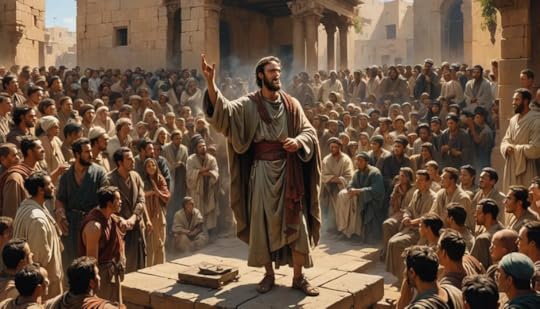 PMW 2024-055 by Kenneth L. Gentry, Jr.
PMW 2024-055 by Kenneth L. Gentry, Jr.
I began this brief series to introduce the preterist approach to Revelation to those who might be unfamiliar with it. And there are about 7.95 billion of those people. (I would really like to tap into that market!) In the first article I laid down the founding principle: temporal indicators. In this article we will move on to a second exegetical indicator:
Audience Indicators. John emphasizes the nearness of his prophetic events, in a way most relevant to his original recipients. In fact, to delay the prophetic events thousands of years would contradict his whole point in writing Revelation.
First, John writes to seven historical churches. Immediately after twice declaring the nearness of the events (1:1, 3) we read: “John to the seven churches that are in Asia” (1:4a). In 1:11 and 2:1–3:22 he specifically names the churches. John informs these first century churches of events ‘soon’ (1:1) to come to pass because “the time is near” (1:3). How could they have understood John to really mean that either 2,000 years would elapse before the events broke out or that they would drag on and repeat themselves for 2000 years?
The Beast of Revelation
by Ken Gentry
A popularly written antidote to dispensational sensationalism and newspaper exegesis. Convincing biblical and historical evidence showing that the Beast was the Roman Emperor Nero Caesar, the first civil persecutor of the Church. The second half of the book shows Revelation’s date of writing, proving its composition as prior to the Fall of Jerusalem in A.D. 70. A thought-provoking treatment of a fascinating and confusing topic.
For more study materials, go to: KennethGentry.com
Second, studies by William Ramsey and Colin Hermer show how intimately Revelation addresses those specific churches regarding their histories, settings, and struggles. The seven letters are occasional letters designed specifically for their concerns.
Third, within these letters we also find temporal qualifiers suggesting those churches would experience the shock waves from the events of Revelation (2:5; 2:16; 3:11; 22:12, 20). One of them was “about to” be tried by Satan (2:10; cp. 1:19 Gk.). To another Christ is “coming quickly” in judgment (2:16; cp. 1:1). To still another He promises: “I also will keep you from the hour of testing, that hour which is about to come upon the whole world [oikumene]” (3:10; cp. 1:19 Gk.). Indeed, a church must “hold fast” for awhile in that Christ’s judgment-coming will trans transpire “quickly” (3:11; cp. 1:1).
Four Views on the Book of Revelation
(ed. by Marvin Pate)
Helpful presentation of four approaches to Revelation. Ken Gentry writes the chapter on the preterist approach to Revelation, which provides a 50 page survey of Revelation .
See more study materials at: www.KennethGentry.com
Fourth, John wrote Revelation while these churches were enduring stressful times: “I, John, your brother and fellow partaker in the tribulation and kingdom and perseverance which are in Jesus” (1:9a). Revelation promises quickly to vindicate the martyrs who cry: “How long?” (6:9). The were told “they should rest for a little while longer” (6:10-11; cp. Lk 18:7-8). In fact, later in Revelation, we learn “there shall be delay no longer” (10:6). Yet, on the non-preterist interpretation, their vindication was not after “a little while,” and the events await an enormous delay.
And the beat goes on. In my next article I will discuss a third principle for preterism in Revelation.
The Reformed Eschatology of Geerhardus Vos
Ed. by Ken Gentry and Bill Boney
This collection of several key eschatological studies by the renowned theologian Geehardus Vos will be published in late Summer or early Fall 2024. We have modernized Vos’ grammar and syntax and updated his publications according to modern style conventions (shorter sentences and paragraphs).
For information on the upcoming Geerhardus Vos work, see:
https://axeheadpress.com/pages/coming-soon-vos
July 9, 2024
PRETERISM IN REVELATION (1)
 PMW 2024-054 by Kenneth L. Gentry, Jr.
PMW 2024-054 by Kenneth L. Gentry, Jr.
In light of the release (finally!) of my commentary on Revelation, I thought it might be helpful to introduce four basic principles that provide exegetical justification for preterism therein. Many are unfamiliar with the preterist understanding of Revelation. These justifications are rooted in interpretive demands derived from the text itself, not from theological predispositions (e.g., anti-premillennialism) or from traditional predilections (e.g., John Lightfoot emulation). By doing this, I hope these articles might be a brief “tract” to help introduce family and friends to this very different approach than that held by Hal Lindsey and Tim LaHaye.
The leading preterist evidence derives from John’s temporal delimitations, which he emphasizes by strategic placement, didactic assertion, frequent repetition, and careful variation.
He strategically places them twice in his introduction (1:1, 3) and five times in his conclusion (22:6, 7, 10, 12, 20), thereby bracketing the highly wrought drama within (4:1–22:6). In these didactic passages John employs two terms demanding preterism: tachos / tachu (1:1, cp. 22:7, 12, 20) and eggus (1:3; cp. 22:10). For example:
The Revelation of Jesus Christ, which God gave Him to show to His bond-servants, the things which must shortly [tachos] take place. . . . Blessed is he who reads and those who hear the words of the prophecy, and heed the things which are written in it; for the time is near [eggus]. (1:1a, 3)
The Divorce of Israel: A Redemptive-Historical Interpretation of Revelation
This long-awaited commentary has now been published. It is an 1800 page, two-volume deeply exegetical, academic commentary on the Bible’s most mysterious book.
See more study materials at: www.KennethGentry.com
John immediately impresses upon his reader the nearness of his prophetic events.
Lexicographers agree on the temporal significance of tachos in Revelation: The Baur-Arndt-Gingrich-Danker Lexicon (BAGD) notes that en tachei means: “soon, in a short time Lk 18:8; Ro 16:20; 1 Ti 3:14 v.1; Rv 1:1; 22:6; 1 Cl 65:1; shortly Ac 25:4.” Thayer offers the following range of meanings: “quickness, speed and quickly, shortly, speedily, soon,” listing Revelation 1:1 and 22:6 with the “speedily, soon” entries. Abbott-Smith concurs: 1:1 and 22:6 mean “quickly, speedily, soon.” Greek text editors F. J. A. Hort, Kurt Aland, and Howard Marshall agree. Hort translates it “shortly, soon.” Kurt Aland comments: “In the original text, the Greek work used is tachu, and this does not mean ‘soon,’ in the sense of ‘sometime,’ but rather ‘now,’ immediately.” Howard Marshall cites Revelation 1:1 and 22:6 as evidence that the normal use of the phrase en tachei “suggest[s] that soon is the meaning.”
In fact, all English versions translate it either as: “soon” (NIV, RSV, Beck, NRSV, NAB, CEV), “shortly” (KJV, ASV, Weymouth, NEB, NASB, NKJV), or “very soon” (Moffatt, Phillips, Williams, TEV). Tachos obviously indicates temporal brevity elsewhere (e.g., Lk 18:8; Ac 12:7; Ro 16:20). The same is true of its related form tachus (Mt 5:25; Mk 9:39; Lk 15:22; cp. Rev 2:16; 3:11; 11:14; 22:7, 12, 20).
This evidence is reinforced by John’s linking tachos with eggus in the same contexts, as if to provide a two-fold witness (1:1, 3; 22:6, 10). BAGD provides the following entry for eggus: “of time near a. of the future: kairos Mt 26:18; Rv 1:3; 22:10.” The other lexicons cited above concur. TDNT notes that the term means “temporally near at hand” and observes that “like the Synpt., Rev. uses eggus only as a term for the near coming of the kingdom of God. Thus we have ho gar kairos eggus in 1:3; cf. 22:10″ (3:330, 331). The various samples of eggus in the NT all agree: some relating spatial, others temporal nearness (Mt 24:32, 33; 26:18; 13:28, 29; Lk 19:11; 21:30, 31). And again, all translations of Revelation agree; all versions cited above have either “near” or “at hand.”
BEFORE JERUSALEM FELL
Doctoral dissertation defending a pre-AD 70 date for Revelation’s writing (459 pp; paperback). Thoroughly covers internal evidence from Revelation, external evidence from history, and objections to the early date by scholars.
For more study materials: https://www.kennethgentry.com/
Perhaps the most interesting proof of the meaning of these terms is the various competing, innovative, counter-intuitive attempts to get around their obvious significance! Indeed, if these terms do not express temporal nearness, what terms could John have used to do so? I am firmly convinced John prophesies the fast approaching destruction of the Temple in A.D. 70.
But there is more! See you next time.
The Reformed Eschatology of Geerhardus Vos
Ed. by Ken Gentry and Bill Boney
This collection of several key eschatological studies by the renowned theologian Geehardus Vos will be published in late Summer or early Fall 2024. We have modernized Vos’ grammar and syntax and updated his publications according to modern style conventions (shorter sentences and paragraphs).
For information on the upcoming Geerhardus Vos work, see:
https://axeheadpress.com/pages/coming-soon-vos
July 5, 2024
PAEDO-BAPTISM VS. PAEDO-COMMUNION
PMW 2024-053 by Purely Presbyterian
Gentry note: I received this article from “Purely Presbyterian” by email the other day and thought it worthy of promotion on my website (since I am a Westminster Confessionalist).
PAEDO-BAPTISM, YES; PAEDO-COMMUNION, NO
A common objection against infant baptism by credo-baptists is that if children are to be baptized, then, for the sake of consistency, they ought to also be admitted to the Lord’s Supper. In other words, the logical conclusion of infant baptism necessarily leads to the absurdity of infant communion; paedocommunion is obviously unbiblical and absurd, therefore paedobaptism must likewise be unbiblical. In like manner, paedocommunion advocates endorse the same logic, but instead of denying both infant baptism and infant communion, they affirm and practice both under the same pretense of consistency (cf. Infant Communion? By Douglas Wilson). Since paedobaptism is true, paedocommunion is likewise true, and it is inconsistent to treat them differently by giving one sacrament to infants but not the other.
But is this charge of inconsistency a valid criticism of confessional Reformed sacramentology?
Baptists and Paedocommunionists both hold to the same naive and superficial assumption: “Since Baptism and the Lord’s Supper are both sacraments, they must also have the same qualifications for partaking worthily.” But this is not a sound conjecture, it is a false analogy. On the contrary, confessional Reformed Theology rightly affirms that the Lord Jesus Christ defines the manner in which each sacrament ought to be partaken of—and he does so in harmonious consistency with the nature, use, and ends that he himself instituted for each sacrament respectively.
Unto You and Your Children By Larry E. Ball
By Larry E. Ball
This book defines and illustrates the covenant as it appears in the Bible, and then demonstrates how the covenant affects our children as we raise them in the church. It also develops a justification for infant (covenant) baptism.
However, before the writer examines the idea of the covenant in the Bible, he first covers a number of other topics that a person needs to understand before he can understand the covenant. He spends at least one chapter revisiting the gospel. What is the gospel? He then establishes the meaning of such words as regeneration, conversion, election, and salvation. He is convinced that before a person can properly understand the covenant and covenant baptism there must be some agreement on the definition of these other terms.
See more study materials at: www.KennethGentry.com
1) COVENANT STATUS & THE REQUIREMENTS FOR PARTAKING.
First, due to their covenant status, personal acts of faith (such as a credible profession) are not necessary for infants to be baptized, but yet they are necessary for them to partake of the Lord’s Supper.
A credible profession of faith, as validated by the elders of the church, is required of those outside of the visible church in order for them to join the covenant community. Converts to Christianity must enter the covenant community first, by professing faith in Christ, and then they can be admitted to the sacrament of baptism (Mark 16:15-16; Acts 8:37-38). However, infants of believers are already members of the covenant community, and are federally holy (Gen. 9:9; Gen. 17:10; Acts 2:39; 1 Cor. 7:14; cf. WLC 166). As members of the visible church, covenant infants have a right to the initiatory sacrament of baptism. That is why a profession of faith is not required of covenant infants before receiving baptism. [1]
Unlike the requirements for adult baptism, the requirements for worthily partaking of the Lord’s Supper are not given to unbelievers, but rather to the covenant community. There is no similar twofold requirement for this sacrament like there is for baptism with regard to unbelieving adults vs covenant children. This sacrament is exclusively for covenant members, not for outsiders of the covenant—which is why the prerequisites for worthy partaking are the same for all those who already are covenant members. These prerequisites are remembering Christ (1 Cor. 11:24-25), self-examination (1 Cor. 11:28; 2 Cor. 13:5), discerning the Lord’s body and blood (1 Cor. 11:27, 29), taking, eating, and drinking the bread and the wine (1 Cor. 11:24-25), not just physically, but spiritually by faith (John 6:35; 1 Cor. 11:26). As William Ames wrote,
“Baptism ought to be administered to all those in the covenant of grace, because it is the first sealing of the covenant now first entered into… But the Supper is to be administered only to those who are visibly capable of nourishment and growth in the church. Therefore, it is to be given not to infants, but only to adults.” (Marrow of Theology I.xl.11, 18, pp. 211 & 212)
Baptism requires covenant membership, which is obtained either by birth or by profession of faith. Covenant children are not an exception to this rule. Communion requires not only covenant membership, but also multiple spiritual exercises which are not required for any party in baptism. Of these spiritual exercises, John Calvin writes, “Nothing of the kind is prescribed by baptism. Wherefore, there is the greatest difference between the two signs [baptism & communion].” He continues with an analogy from the old covenant sacraments:
“This also we observe in similar signs under the old dispensation. Circumcision, which, as is well known, corresponds to our baptism, was intended for infants, but the Passover, for which the Supper is substituted, did not admit all kinds of guests promiscuously, but was duly eaten only by those who were of an age sufficient to ask the meaning of it (Exod. 12:26).” (Institutes of the Christian Religion IV.xvi.30)
Hence it is clear that the prerequisites for baptism are not comparable to those for the Lord’s Supper. The requirement for baptism is that one be a member of the visible church, yet one may become a member of the visible church in two ways. Non-covenanted individuals outside the church must profess faith in Christ to join the church and be baptized, whereas members of the church already have a right to baptism. However, the requirements for the Lord’s Supper, discussed above, cannot be met in multiple ways.
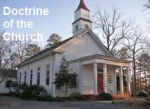 Christ’s Church (20 mp3 downloads)
Christ’s Church (20 mp3 downloads)
by Ken Gentry
An in-depth sermonic presentation of the doctrine of the church. This is vitally important today with the evangelical church not living up to its biblical calling
See more study materials at: www.KennethGentry.com
2) THE MANNER OF PARTICIPATION.
Secondly, the recipient is passive in baptism, but active in communion. One is baptized by being a covenant member, and having water poured on the head, whereas in communion there are several physical and spiritual actions that must take place. The participant does not baptize himself, but in communion, the participant takes, eats, drinks, and remembers.
The Reformed Eschatology of Geerhardus Vos
Ed. by Ken Gentry and Bill Boney
This collection of several key eschatological studies by the renowned theologian Geehardus Vos will be published in late Summer or early Fall 2024. We have modernized Vos’ grammar and syntax and updated his publications according to modern style conventions (shorter sentences and paragraphs).
For information on the upcoming Geerhardus Vos work, see:
https://axeheadpress.com/pages/coming-soon-vos
This passive and active manner of participation corresponds to the Christ-ordained ends of the two sacraments respectively. Baptism represents regeneration (Titus 3:5)—which is an irresistible act of the Holy Ghost upon the passive person (John 3:8) bringing him to spiritual life (Ezekiel 37:1-10; Eph. 2:5) and giving him a new heart (Ezekiel 36:26). Yet, Communion represents active faith (John 6:35; 1 Cor. 11:26)—which is an act of the believer reaching out and taking hold of Christ for himself unto salvation (John 1:12; Acts 15:11; 16:31; Gal 2:20). It is important to remember that justifying faith consists of three components: knowledge of the gospel message (notitia), intellectual assent acknowledging the truth of the gospel message (assensus), and wilful trust in, and a faithful apprehending of, the promises of God in Christ unto oneself (fiducia). This knowledge and assent are intellectual actions, and fiducial trust is an act of the will [2] — all three of which infants in their stage of development are not yet capable of (Isa. 7:16; Rom. 10:17; 12:1). [3] Yet, regeneration, being the sole act of the Holy Ghost, infants are capable of receiving (John 3:8). As Robert Baillie (1602-1662) wrote,
“[Infants] are not capable of the whole signification of the Lord’s Supper, for the thing signified therein is not the Lord’s body and blood simply, but his body to be eaten, and his blood to be drunken, by the actual faith of the communicants; of this active application infants are not capable; but in baptism no action is necessarily required of all who are to be baptized; for as the body may be washed without any action of the party who is washed: so the virtue of Christ’s death and life may be applied in remission and regeneration, by the act of God alone to the soul as a mere patient without any action from it.” (Anabaptism, the True Fountain of Independency, pp. 151-152).
Furthermore, this “taking,” “eating,” and “drinking” in the Supper are not only to be understood as physical actions, but as the spiritual actions of the subject. As Augustine said, “Why dost thou prepare thy teeth and belly? Believe, and thou hast eaten.” (Tractate 25). Matthew Henry similarly comments,
“This is here exhibited, or set forth, as the food of souls. And as food, though ever so wholesome or rich, will yield no nourishment without being eaten, here the communicants are to take and eat, or to receive Christ and feed upon him, his grace and benefits, and by faith convert them into nourishment to their souls.” (Com. 1 Cor. 11:24). [4]
Hence, infants are capable of physically and spiritually participating in baptism (passively), but are not capable of participating actively in the Lord’s Supper. This will become more clear in our next point.
Ecclesiology Course
25 Gentry downloadable class lectures. Full Christ College course lectures on the doctrine of the Church.
Includes sizeable study of the sacraments.
See more study materials at: www.KennethGentry.com
3) THE EFFICACY OF THE SACRAMENTS.
Thirdly, regarding the efficacy of the sacraments. Infants benefit from baptism outwardly and are able to inwardly, whereas they can not benefit from the Supper in either way.
To finish reading this article and viewing the footnotes, go to:
Kenneth L. Gentry Jr.'s Blog
- Kenneth L. Gentry Jr.'s profile
- 85 followers



